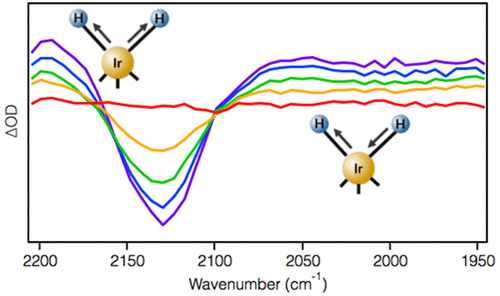当前位置:
X-MOL 学术
›
J. Phys. Chem. A
›
论文详情
Our official English website, www.x-mol.net, welcomes your feedback! (Note: you will need to create a separate account there.)
Ultrafast Dynamics of the Metal-to-Ligand Charge Transfer Excited States of Ir(III) Proteo and Deutero Dihydrides
The Journal of Physical Chemistry A ( IF 2.9 ) Pub Date : 2018-04-19 00:00:00 , DOI: 10.1021/acs.jpca.8b02266 Chelsea M. Taliaferro 1 , Evgeny O. Danilov 1 , Felix N. Castellano 1
The Journal of Physical Chemistry A ( IF 2.9 ) Pub Date : 2018-04-19 00:00:00 , DOI: 10.1021/acs.jpca.8b02266 Chelsea M. Taliaferro 1 , Evgeny O. Danilov 1 , Felix N. Castellano 1
Affiliation

|
For decades, transition metal hydrides have been at the forefront of numerous photocatalytic reactions leveraging either photoacid or photohydride generation. Of upmost importance is the nature of the M–H bond itself, which is typically the major site of photochemical reactivity, particularly in Ir(III) hydrides featuring metal-to-ligand charge transfer (MLCT) excited states. As a departure point for understanding the fundamental spectroscopy and photophysics of the MLCT excited states of Ir(III) diimine hydrides, cis-[Ir(bpy)2H2]+ (bpy = 2,2′-bipyridine) and its deuterated analogue cis-[Ir(bpy)2D2]+ were prepared and investigated. The robust nature of these molecules enabled detailed solution-based photophysical studies using ultrafast transient absorption and infrared spectroscopy, executed without the generation of permanent photoproducts. Static Fourier transform infrared and Raman spectra (λex = 785 nm) of these two molecules revealed weak but measurable Ir–H and Ir–D stretching vibrations centered at 2120 and 1510 cm–1, respectively. Short-lived (τ = 25 ps) MLCT excited states were observed for both cis-[Ir(bpy)2H2]+ and cis-[Ir(bpy)2D2]+ following femtosecond pulsed laser excitation at 480 nm in visible and near-IR transient absorption experiments. A similar time constant was measured for the in-phase and out-of-phase Ir–H stretching modes of the triplet excited state between 1900 and 2200 cm–1 using transient IR spectroscopy. The Ir–D stretching modes in the MLCT excited state were masked by bpy-localized vibrations rendering quantitative evaluation of these modes difficult. The time-resolved infrared data were consistent with density functional theory calculated mid-IR difference spectra in both of these molecules, yielding quantitative matches to the measured IR difference spectra. The information presented here provides valuable insight for understanding the primary photophysical events and transient absorption and IR spectroscopic signatures likely to be encountered throughout metal hydride photochemistry.
中文翻译:

Ir(III)蛋白质和氘代二氢化物的金属到配体电荷转移激发态的超快动力学
几十年来,过渡金属氢化物一直处于利用光酸或光氢化物生成的众多光催化反应的最前沿。最重要的是M–H键本身的性质,它通常是光化学反应的主要部位,尤其是在具有金属到配体电荷转移(MLCT)激发态的Ir(III)氢化物中。作为理解Ir(III)二亚胺氢化物MLCT激发态的基本光谱学和光物理的出发点,顺式-[Ir(bpy)2 H 2 ] +(bpy = 2,2'-联吡啶)及其氘代类似物顺式-[Ir(bpy)2 D 2 ] +准备和调查。这些分子的强大特性使他们能够使用超快速瞬态吸收和红外光谱进行详细的基于溶液的光物理研究,而无需产生永久的光产物。这两个分子的静态傅立叶变换红外光谱和拉曼光谱(λex = 785 nm)显示出微弱但可测量的Ir–H和Ir–D拉伸振动分别集中在2120和1510 cm –1处。短命(τ= 25皮秒)观察两者MLCT激发态顺式-物[Ir(联吡啶)2 ħ 2 ] +及顺式-物[Ir(联吡啶)2 d 2 ] +在可见光和近红外瞬态吸收实验中,在480 nm处使用飞秒脉冲激光激发。在1900和2200 cm –1之间的三重激发态的同相和异相Ir-H拉伸模式下测量了相似的时间常数使用瞬态红外光谱。在MLCT激发态下的Ir–D拉伸模式被bpy局部振动所掩盖,从而难以对这些模式进行定量评估。时间分辨的红外数据与密度泛函理论计算的这两个分子的中红外差光谱一致,与所测得的红外差光谱定量匹配。此处提供的信息为了解整个金属氢化物光化学过程中可能遇到的主要光物理事件以及瞬态吸收和IR光谱特征提供了宝贵的见识。
更新日期:2018-04-19
中文翻译:

Ir(III)蛋白质和氘代二氢化物的金属到配体电荷转移激发态的超快动力学
几十年来,过渡金属氢化物一直处于利用光酸或光氢化物生成的众多光催化反应的最前沿。最重要的是M–H键本身的性质,它通常是光化学反应的主要部位,尤其是在具有金属到配体电荷转移(MLCT)激发态的Ir(III)氢化物中。作为理解Ir(III)二亚胺氢化物MLCT激发态的基本光谱学和光物理的出发点,顺式-[Ir(bpy)2 H 2 ] +(bpy = 2,2'-联吡啶)及其氘代类似物顺式-[Ir(bpy)2 D 2 ] +准备和调查。这些分子的强大特性使他们能够使用超快速瞬态吸收和红外光谱进行详细的基于溶液的光物理研究,而无需产生永久的光产物。这两个分子的静态傅立叶变换红外光谱和拉曼光谱(λex = 785 nm)显示出微弱但可测量的Ir–H和Ir–D拉伸振动分别集中在2120和1510 cm –1处。短命(τ= 25皮秒)观察两者MLCT激发态顺式-物[Ir(联吡啶)2 ħ 2 ] +及顺式-物[Ir(联吡啶)2 d 2 ] +在可见光和近红外瞬态吸收实验中,在480 nm处使用飞秒脉冲激光激发。在1900和2200 cm –1之间的三重激发态的同相和异相Ir-H拉伸模式下测量了相似的时间常数使用瞬态红外光谱。在MLCT激发态下的Ir–D拉伸模式被bpy局部振动所掩盖,从而难以对这些模式进行定量评估。时间分辨的红外数据与密度泛函理论计算的这两个分子的中红外差光谱一致,与所测得的红外差光谱定量匹配。此处提供的信息为了解整个金属氢化物光化学过程中可能遇到的主要光物理事件以及瞬态吸收和IR光谱特征提供了宝贵的见识。


























 京公网安备 11010802027423号
京公网安备 11010802027423号